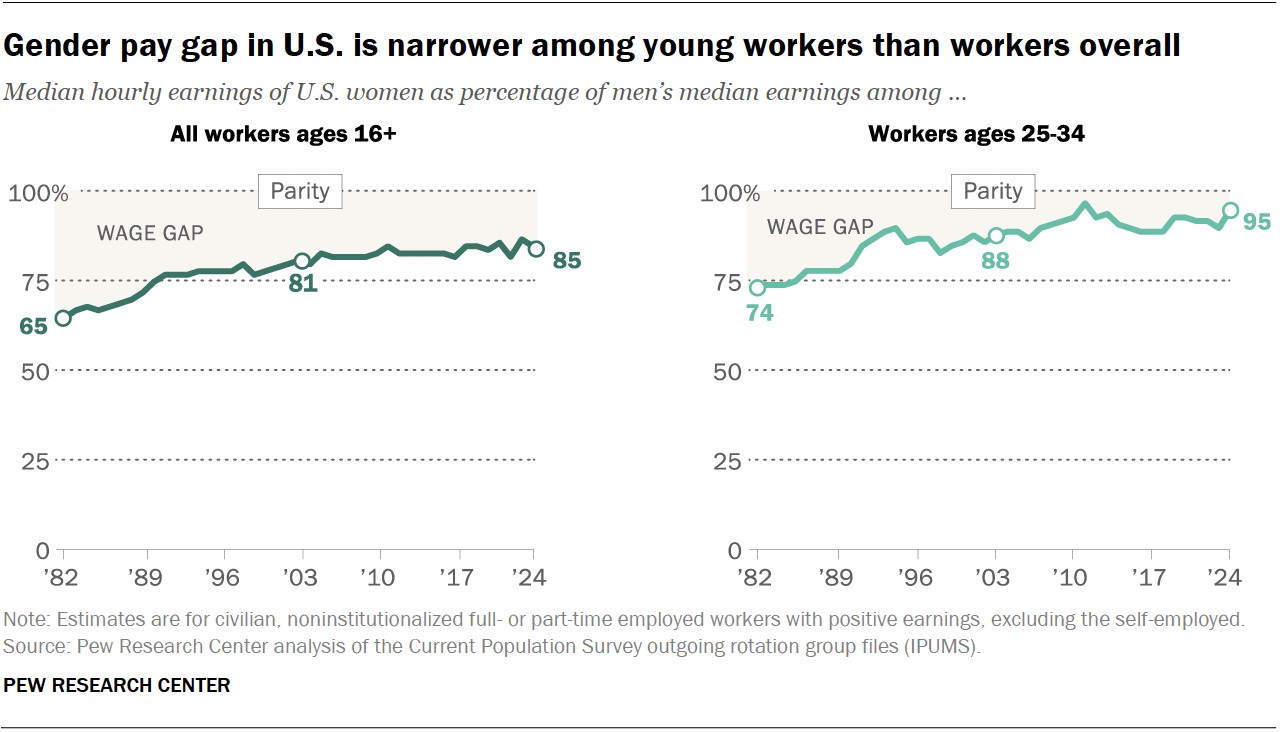The gender pay gap, a persistent issue in the U.S. economy, reflects the difference in earnings between men and women. In 2024, women earned 85% of what men earned, a slight improvement from 81% in 2003, according to a Pew Research Center analysis. This translates to a 15-cent gender pay gap for all workers in 2024.
The Gender Pay Gap: A Generational Divide
While the overall gap persists, younger workers experience a smaller disparity. Women aged 25 to 34 earned 95 cents for every dollar earned by men in the same age group in 2024, representing a 5-cent gap. This suggests a potential narrowing of the gap over time as younger generations enter the workforce.
Long-Term Trends and Contributing Factors
The 15-cent gap in 2024 represents a significant decrease from the 35-cent gap in 1982. Similarly, the gap for workers aged 25 to 34 shrunk from 26 cents to 5 cents over the same period. This progress can be attributed to women’s increased educational attainment, broader occupational representation, and accumulated work experience. However, occupational segregation, with women remaining overrepresented in lower-paying jobs, continues to be a contributing factor.
The U.S. Census Bureau’s 2023 data, focusing on full-time, year-round workers, showed women earning 83% of men’s earnings. While this differs slightly from the Pew Research Center’s analysis, which includes part-time workers, it underscores the persistent pay disparity.
Beyond Measurable Factors: Perception and Discrimination
Measurable factors alone do not fully explain the gender pay gap. Factors like gender discrimination, though difficult to quantify, likely play a role. A Pew Research Center survey revealed that half of U.S. adults believe employers treating women differently is a major reason for the gap. Other perceived contributing factors include women’s choices regarding work-life balance (42%) and their concentration in lower-paying jobs (34%).
The Pressure of Work and Family: A Gendered Experience
Working women, especially mothers, often face greater pressure to prioritize home responsibilities. Nearly half of employed women (48%) reported feeling significant pressure in this area, compared to 35% of employed men. This disparity is even more pronounced among working parents, with 67% of mothers and 45% of fathers feeling substantial pressure to focus on home responsibilities. While financial pressures are similar for working moms and dads, unmarried working mothers experience a disproportionately high level of financial strain (77%).
Leadership Aspirations and Gender
Men are more likely than women to hold leadership positions (28% vs. 21%), a trend particularly evident among employed fathers (35%). Women are also more likely to express a lack of desire for leadership roles in the future (46% vs. 37% of men). This suggests potential differences in career aspirations and societal expectations that may contribute to the gender pay gap.
Conclusion
Despite progress over time, the gender pay gap remains a complex issue influenced by a combination of measurable factors, societal perceptions, and potentially discriminatory practices. While younger generations experience a smaller gap, significant disparities persist, highlighting the ongoing need for addressing this economic inequality. Understanding the multifaceted nature of the problem is crucial for developing effective solutions that promote equal pay for equal work.


